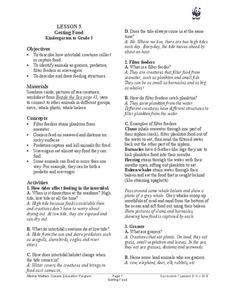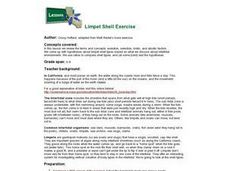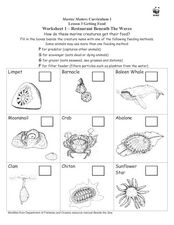Curated OER
Barnacles: Harder than Cement
Fourth graders watch the movements of the complex animal hidden inside the tiny barnacle shells. This lesson allows students to study the behavior, adaptation, and larval stage of the barnacle.
Curated OER
Salt Water Revival
Students produce a high tide. In this Marine Biology lesson plan, students visit a tide pool to investigate the creatures response to changes in the tide. Students discuss the results of their experimentation.
Curated OER
Symbiotic Relationships
Offering a comprehensive overview of symbiotic relationships, this presentation would be a great way to introduce or review material covered in a biology class. There are definitions, examples, and a quiz on the meaning of parasitism,...
Curated OER
Zooplankton
Holoplankton are always plankton, whereas meroplankton are only plankton as larvae. Reveal several examples of each to your young marine biologists with this PowerPoint presentation. The first seven slides, an introduction to...
Kentucky School for the Deaf
Levels of Organization within an Ecosystem
From tiny organisms to entire biomes, young scientists examine the interdependent relationships tying all living and non-living things together with this collection of ecology resources.
Indiana Science
How Many E’s?
Seventh graders explore random sampling by estimating the number of e's on the newspaper. They explain the possible error sources for this type of sampling, and compare the accuracy of sampling a small and large population. This is a...
Curated OER
Plankton in the Air
Here is a lab activity adequate for use with any full lesson on environmental factors that shape animal adaptations or marine animal characteristics. Pupils will discuss the role plankton plays in the environment and filter-feeding...
Shelby County Schools
How Ecosystems Work
How does one organism get its energy? What is the main source of energy in an ecosystem? How does the flow of energy affect different types of ecosystems? Answer these questions with a fill-in-the-blank worksheet.
New South Wales Department of Education
Invertebrates
Of all invertebrates, insects by far are the most numerous. Scholars discuss invertebrates and then use a key to classify them. They see different examples and must describe features of each organism based upon the key.
Curated OER
Tide Pool Discovery
First graders visit the Discovery Pool, where they use their senses to investigate the different tide pool species. They touch different species. Students describe how each one feels, and what they look like in words. They draw the...
Curated OER
What Should You Know about Classification?
Many learners have a tough time picking out pertinent information from a text or in class. Sometimes, all it takes is a study/reading guide to show them the way. The activity here focuses on taxonomy and classification, including...
Curated OER
Life Cycle: Diversity in a Balance
In this life cycle workbook, 3rd graders complete several different activities in which they analyze different invertebrates, identify arthropods, examine human biology and plants, and study natural environments. 20 different activities...
Curated OER
The Intertidal Zone: Tide and How Creatures Survive
Young scholars explore oceanography by completing science worksheets. In this tide pools lesson, students discuss the forces of the tide pools, the animals that live within them, and the impact they have on the rest of the ocean. Young...
Curated OER
Heading South
Students look at the migration of different birds. In this migration instructional activity, students discuss why an animal migrates and problems that can occur during migration. They look at several downloadable maps that show the...
Curated OER
Beach Life: Spanish Banks Field Trip
Students discover beach life. In this beach life instructional activity, students visit a beach to find plant and animal species that live there. They discuss the life cycle and needs of some of these animals through a variety of...
Curated OER
Invertebrate Vocabulary-- Marine Invertebrate Match
In this science worksheet, students study 12 vocabulary words which pertain to marine invertebrates. Students read the definitions which include pronunciation, part of speech and meaning of the name. Students then look at 16 organisms...
Curated OER
Energy Through the Ecosystem
In this ecosystem worksheet, students use a diagram of an ocean-based food web to complete 5 short answer questions about the energy flow through this ecosystem.
Curated OER
Getting Food
Students complete activities to learn about the ocean food web. For this ocean life lesson, students discuss how the tides affect feeding, learn about filter feeders, grazers, predators, and scavengers. Students then group the animals...
Curated OER
Getting Food
Students explore seashore ecosystems. In this marine animal biology lesson, students sort photographs of various sea creatures according to their eating habits and discuss each animal's identifiable traits. Students draw and label...
Curated OER
Crustacean Critters
Students explore the habitats of hermit crabs. In this crustacean lesson, students discover what animals need to survive. Working with live hermit crabs, students explore how hermit crabs have adapted to their habitats.
Curated OER
Limpet Shell Exercise
Students review the terms and concepts: evolution, selection, biotic, and abiotic factors. They come up with hypotheses about limpet shell types based on what we discuss about intertidal environments. Students use ratios to compare...
Curated OER
What is an Animal?
In this animal classification worksheet, students will review the characteristics used in classifying animals including the development of animals. Students will compare the endoderm, ectoderm, and mesoderm. This worksheet has 4 short...
Curated OER
Restaurant Beneath the Waves
In this marine life worksheet, students fill in the boxes beside each ocean creature name with one of the following feeding methods: predator, scavenger, grazer, and filter feeder. Students then list or draw marine creatures that use the...
Curated OER
ANIMALS OF ANTARCTICA
Pupils are introduced to the animals of Antarctica and how they adapt to their environment and the changes of the seasons after being read the story,"Counting Penguins" . They pick an animal and predict how he/she thinks this animal...

























